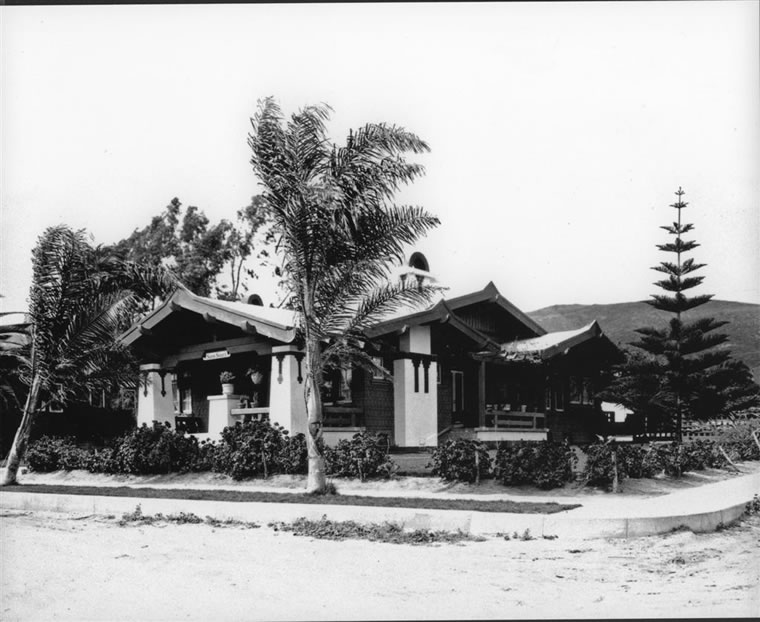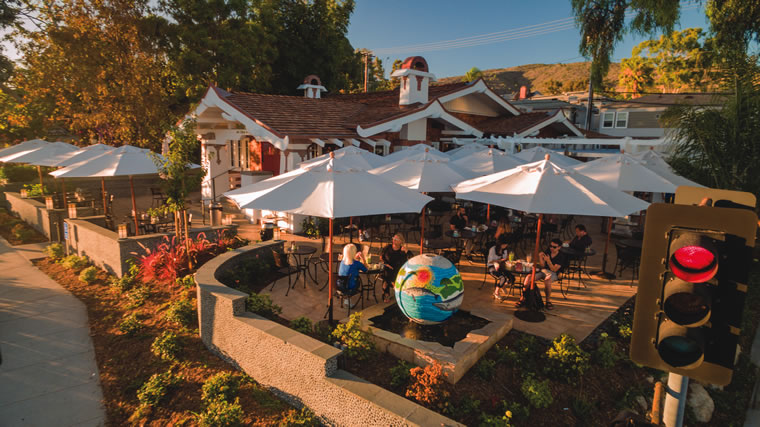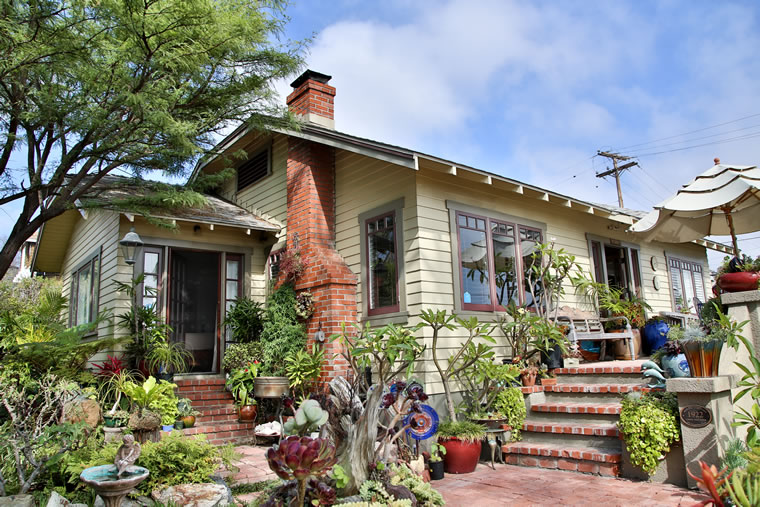
With its multigabled roofline and ornamental chimneys, the iconic Craftsman-style bungalow at the corner of North Coast Highway and Cliff Drive is a throwback to a simpler time. Constructed in 1917, the building was once a single-family residence and became the site of The Cottage Restaurant in 1964. Almost three years ago, we received word that LA-based Urth Caffé would be taking over the space, but it wasn’t until last summer that ground finally broke.
It’s apparent why: Renovating the “E”-rated property (the highest designation of historical integrity) was hardly an easy task. Owners worked for months with a consultant to restore the structure to its earlier glory and add small details that pay homage to its past—a sign over the doorway that reads “Urth Caffé at the Cottage,” for example. Exterior modifications helped bring the building back to its original charm with the removal of some enclosed porches and the addition of a trellis to the side patio area. Finally, the rehabilitated space opened for business in September.
Hundreds of these successfully renovated historical properties exist within our borders, representing numerous architectural styles and contributing to the city’s one-of-a-kind style. The task may be arduous, with myriad steps ranging from filing applications to fixing interiors, but—as Urth Caffé demonstrated—perseverance pays off in maintaining these structures for future generations of Lagunans to enjoy.
Pushing Papers

From a survey conducted 1980 to 1981, the Laguna Beach Historic Inventory was developed to catalog hundreds of buildings eligible for the city’s Historic Register. These structures have deep-rooted city ties, whether they’re associated with important events or significant individuals; demonstrate distinctive characteristics of a particular architectural style, master architect or builder; or exhibit high artistic value.
For a home on this list to be placed on the register, the owner must submit an application—which includes documentation such as letters of explanation, floor plans and historic photos—to the city’s Heritage Committee for review.
“Every property is very specific and it’s always good for people to come speak with city staff so they know the exact steps for each situation,” says senior city planner Martina Speare. “We don’t have too many blanket situations.”
When considering the purchase or renovation of an older home, it’s important to first investigate its potential historic standing. Approved historic homes receive different ratings: “E” is for exceptional buildings that have outstanding historic integrity and serve as excellent architectural examples; “K” is applied to those that have very good historic integrity and are fine period examples; and “C” is for contributive buildings that add to the overall character and history of the neighborhood but may not be completely unique in themselves.
Laguna Beach architect Todd Skenderian recommends that prospective homebuyers review the property’s file with the city, which provides background and indicates whether it has historical significance. “I have people come to me who are either buying a house or have bought a house and they don’t know that it has historical status,” says Todd, who worked on the Urth Caffé restoration. “And, if they do know it, they don’t know what it means relative to what they can do on the house, what it means relative to the process of approval they need from the city.”
Some locals have been vocal about the frustration of owning a property listed in the inventory—the involuntary designation can prevent homeowners from making desired modifications—but others feel a sense of personal pride in maintaining a piece of history.
“It’s so wonderful to be able to tell the story of your house—that to me means so much more than having a brand new, cold, expensive house,” says Ann Christoph, a local landscape architect whose home is a historic property.
Plus, there are tangible perks: Laguna Beach buildings listed on the city’s Historic Register with “E” and “K” ratings are eligible to apply for the Mills Act. Adopted in 1976 by the California State Legislature, the act enables property owners to get up to 50 percent of the property tax waived so funds can be used instead for maintenance.
Replacing the Nuts and Bolts

Maintaining historical integrity isn’t as simple as keeping up with the routine fixes that come with normal homeownership, however. Any additions or changes to the exterior of the building should be discussed with a planner at City Hall, and may have to be reviewed by the Heritage Committee. Applicants are encouraged to work with licensed architects, historical resource consultants and design professionals, and take advantage of resources such as the Secretary of the Interior’s Standards for Rehabilitation.
“It’s really on a case-by-case basis on what you can do and can’t do, based on what the historic resource is and what’s trying to be preserved,” says Greg Pfost, city community development director.
Two things that remain top of mind for Ann personally are keeping the historic character and being careful to only add to the building in a way that doesn’t ruin its overall scale.
“Preservation means that you save everything you possibly can. … If you need to replace a window, you replace it exactly as it was made originally.” –Ann Christoph
“Preservation means that you save everything you possibly can,” she says. “If there’s some wood that is rotted, try to fix it as much as you can with fillers or whatever you need to make it still work. If that’s not possible, you replace it exactly. If you need to replace a window, you replace it exactly as it was made originally.”
Whether you’re repairing or replacing, retaining character-defining features such as the size, shape and style of windows, doors and chimneys is crucial. For example, doors with beveled glass are characteristic of the Craftsman architectural style, while windows grouped in threes are common for bungalows. Historic preservation also extends to the limits of the property, so fences, sidewalks and lights should be conserved. Owners are encouraged to keep the initial planting design as well.
As Ann suggests, materials are also a key component. With any form of maintenance, the goal is to preserve primary features that are physically visible and set the tone for the property. These could be original wall and siding components, the roofline and architectural millwork. Similarly, authentic facade elements should not be covered or obscured.
“A lot of the times with these buildings, when you’re opening them up, it’s like an archaeological dig because we find architectural elements that were concealed over time and the fun of it is exposing those things and making it part of the building,” Todd says. “At the end of the day, the historical preservation is about the appearance of the home that the general public is going to see when they drive by.”
Making it Modern

While historical ordinance covers the exterior features of the building, there is more flexibility when it comes to making updates to the interior, where contemporary systems like heating, plumbing and electric are especially appreciated. Todd notes that most, if not at all, of these items need to be replaced in older homes.
Local historian and Realtor Andy Alison also stresses the importance of safety and convenience in new amenities: “You want to use modern infrastructure—it’s so much more efficient,” says Andy, who purchased a home near downtown constructed in 1922 by Roy Ropp, credited as the father of Pageant of the Masters. “The old stuff doesn’t work well.”
Todd suggests working with a qualified general contractor who can look at certain functions of the house to determine what can be preserved and what needs to be replaced. “It comes down to that very first meeting you have with the owner and establishing an understanding of what their goals are,” he says. “If their goal is to come in and gut an ‘E’-rated house, it’s not going to happen. If their goal is to gut a ‘C’-rated house, one would need to look at why that house is historically significant from an exterior and interior perspective and then make a determination of which of those interior elements are going to be preserved.”
One way to bring the preservationist ethos inside is to source vintage equipment or furniture from the same decade. Andy says that in the last 20 years, the home building industry has improved significantly as far as putting together appliances and lighting for older homes.
“There are so many companies now that are making quality reproduction fixtures that look old and vintage but that function as new,” he explains.
Repurposing is also a popular and eco-conscious option when it comes to rehabilitating historic homes. In one project, Todd found old bricks sitting around the property and used them to restore some of the old walls and architectural features on the site.
“The goal is to salvage as much as you can and introduce it back into the project rather than just throwing it away and doing something entirely new,” Todd says. “… There are so many ways these materials can be used.”
—Written by Connie K. Ho




